calsfoundation@cals.org
Alligator Snapping Turtle
The alligator snapping turtle (Macrochelys temminckii) is North America’s largest freshwater turtle. This turtle is found primarily in major rivers, streams, swamps, and oxbow lakes throughout much of the south-central United States—all around the states of Arkansas and Mississippi and in portions of Texas, Oklahoma, Kansas, Missouri, Illinois, Iowa, Georgia, and Florida.
Alligator snapping turtles have distinct morphological features that distinguish them from their closest cousin, the snapping turtle (Chelydra serpentina). For example, the dorsal shell, or carapace, of the alligator snapping turtle has three prominent keels (ridges on the carapace), whereas the keels of the snapping turtle are low and become less conspicuous with age. The tails of both species have three rows of tubercles (warty projections), but these scales are more elongated in the snapping turtle. Also, the tail of hatchling alligator snapping turtles is prehensile, meaning that it is able to grasp objects. This allows the young turtle to cling to vegetation or debris in flowing water.
The massive head of the alligator snapping turtle is wedge-shaped anteriorly in young individuals, but it tends to broaden with age. The jaws act like a shearing tool, with the upper jaw being strongly hooked, serving as a cleaver with the lower jaw. The legs are muscular and powerful; the feet have webbed toes with long, pointed claws. In older individuals, the claws become worn and may break off. The head, chin, and neck are dotted with small, flattened, pointed tactile papillae; the eyes are encircled by fleshy extensions of unknown function. The alligator snapping turtle is the only known turtle in the world that possesses an oral predatory lure, which it uses to capture prey. The “lure” is a modified and movable extension of the tongue that resembles a worm or larval insect.
Alligator snapping turtles feed on a wide variety of plants and animals, but fish are their primary prey. Prey other than fish include crayfish, mussels, leeches, aquatic salamanders, snakes, and turtles.
Both genders mature at about eleven to thirteen years of age and are about the same size at that age; thereafter, adult males grow much larger than females. Mating takes place underwater, and the nesting season is during the spring and summer months. Probably leaving the water during the night or early morning, females are known to travel inland over 600 feet to nest. Females dig nest cavities by alternating swipes into the soil with their hind legs. A female may lay from nine to fifty-two eggs per nesting season.
Alligator snapping turtles are highly mobile; in streams, they have been recorded to move a distance of over a mile in less than a month.
As is typical of turtles, the alligator snapping turtle is a long-lived species, and adult males can grow to a massive size. Captive individuals housed in zoo aquaria have been recorded to weigh well over 200 pounds and have carapaces of nearly three feet in length. A male at the Philadelphia Zoo lived to be over eighty years old. Longevity has not been established for turtles in the wild.
Overharvesting from commercial turtling has contributed to drastic declines, especially of adults. The alligator snapping turtle is protected from exploitation in most states, including Arkansas. In 2021, the U.S. Fish and Wildlife Service announced that it was proposing to label the alligator snapping turtle as a threatened species.
For additional information:
Ernst, Carl. H., and Jeffrey E. Lovich. Turtles of the United States and Canada. 2nd ed. Baltimore: Johns Hopkins University Press, 2009.
Howey, Christopher A. F., and Stephen A. Dinkelacker. “Characteristics of a Historically Harvested Alligator Snapping Turtle (Macroclemys temminckii) Population.” Copeia (March 27, 2013): 58–63.
Pritchard, Peter C. H. The Alligator Snapping Turtle: Biology and Conservation. Milwaukee: Milwaukee Public Museum, 1989.
Trauth, Stanley E., Henry W. Robison, and Michael V. Plummer. The Amphibians and Reptiles of Arkansas. Fayetteville: University of Arkansas Press, 2004.
Trauth, Stanley E., J. D. Wilhide, and Anthony Holt. “Population Structure and Movement Patterns of Alligator Snapping Turtles (Macroclemys temminckii) in Northeastern Arkansas.” Chelonian Conservation and Biology 3 (1998): 64–70.
Stanley E. Trauth
Arkansas State University
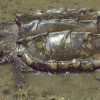 Reptiles
Reptiles Science and Technology
Science and Technology Alligator Snapping Turtle
Alligator Snapping Turtle  Alligator Snapping Turtle Hatchlings
Alligator Snapping Turtle Hatchlings 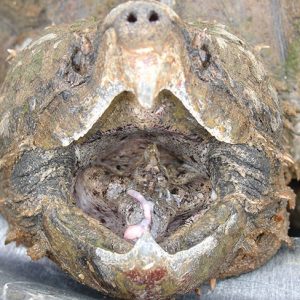 Alligator Snapping Turtle Gullet
Alligator Snapping Turtle Gullet 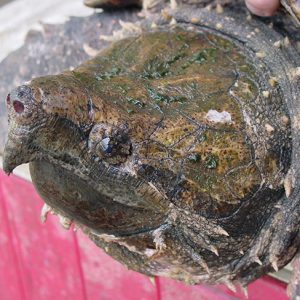 Alligator Snapping Turtle
Alligator Snapping Turtle 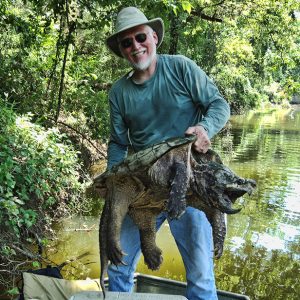 Alligator Snapping Turtle Held by Dr. Trauth
Alligator Snapping Turtle Held by Dr. Trauth 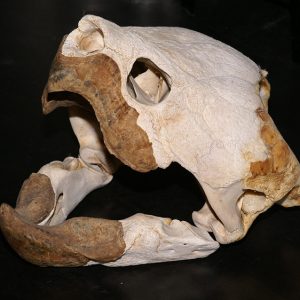 Alligator Snapping Turtle Skull
Alligator Snapping Turtle Skull 



Comments
No comments on this entry yet.